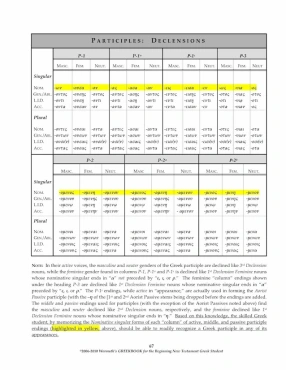So . . . are you slipping on Greek participles when you’d rather be “sipping” on them instead? Here are some tips:
Greek Participles Defined
Participles are verbal adjectives. Being part verb, they have tense, voice and mode, while being part adjective, they also have (as do nouns and adjectives) gender, case, and number. As a result, the parsing of participles is represented through all six of these distinctions: tense, voice, mode, gender, case, and number (e.g., λύων ‒ Present, Active, Participle, Masculine, Nominative, Singular).
Participles may be used “adjectivally” including as a substantive, when no antecedent noun is present. In these instances, as with all adjectives, they agree in gender, case, and number with the nouns or pronouns they modify. Used “adverbially,” participles may receive adverbial modifiers, and may take a direct object.
Declensions
Participles are declined in all three genders: masculine, feminine, and neuter. The masculine active participle is declined like the 3rd Declension masculine, lingual mute stem noun, ἄρχων.* The feminine active participle is declined like the 1st Declension feminine noun, γλῶσσα (whose nominative singular ends in –α, and is not preceded by ε, ι, or ρ). The neuter active participle is declined like 3rd Declension neuter nouns whose stems end in –ματ.
The middle and passive participle endings are declined like 2nd Declension masculines and neuters; the feminine is declined like 1st Declension feminine nouns whose nominative singular ends in -η. Remember Aorist Passive participles always use endings that are active in “appearance.” To get a more comprehensive “satellite view” of Greek Participles formation, click on each of the images, below.


Time
In circumstantial (temporal, adverbial) clauses, the time frame of the participle in translation is related to the tense and time frame of the leading (Indicative) verb. The Present participle is found where the action of the participle is represented as taking place at the same time as the action of the leading (Indicative) verb, regardless of when the action of the leading verb takes place. The action of the Aorist and Perfect participles denote action that has occurred prior to the action denoted by the leading (Indicative) verb, regardless of whether the action of the leading verb is represented as occurring in the past, present, or future. For more on translation of participles, both “Circumstantial” (temporal, adverbial) participles (i.e., those without a definite article), as well as “Articular” (adjectival) participles, see the post, “Participle = Verbal Adjective.” (Also see: Wermuth’s GREEKBOOK (pp. 68-69).
*NOTE: It is imperative that the beginning Greek student learn the declension of the 3rd Declension noun ἀρχῶν, ὁ (ruler). From this noun Present “active” participle endings are derived, and the noun’s stem (ἀρχ-) is replaced with a verbal stem (or, as I like to say in class, “We’re putting Noah back into the ‘ark’ [ἀρχ–] and sending him on a vacation.” The resultant verb stem + declined endings = a verbal-adjective, the grammatical description for a participle (e.g., λύων, λύοντος…).
Go to: Wermuth’s GREEKBOOK.com
Wermuth’s GREEKBOOK Now Available for Purchase as a Watermarked PDF!




















